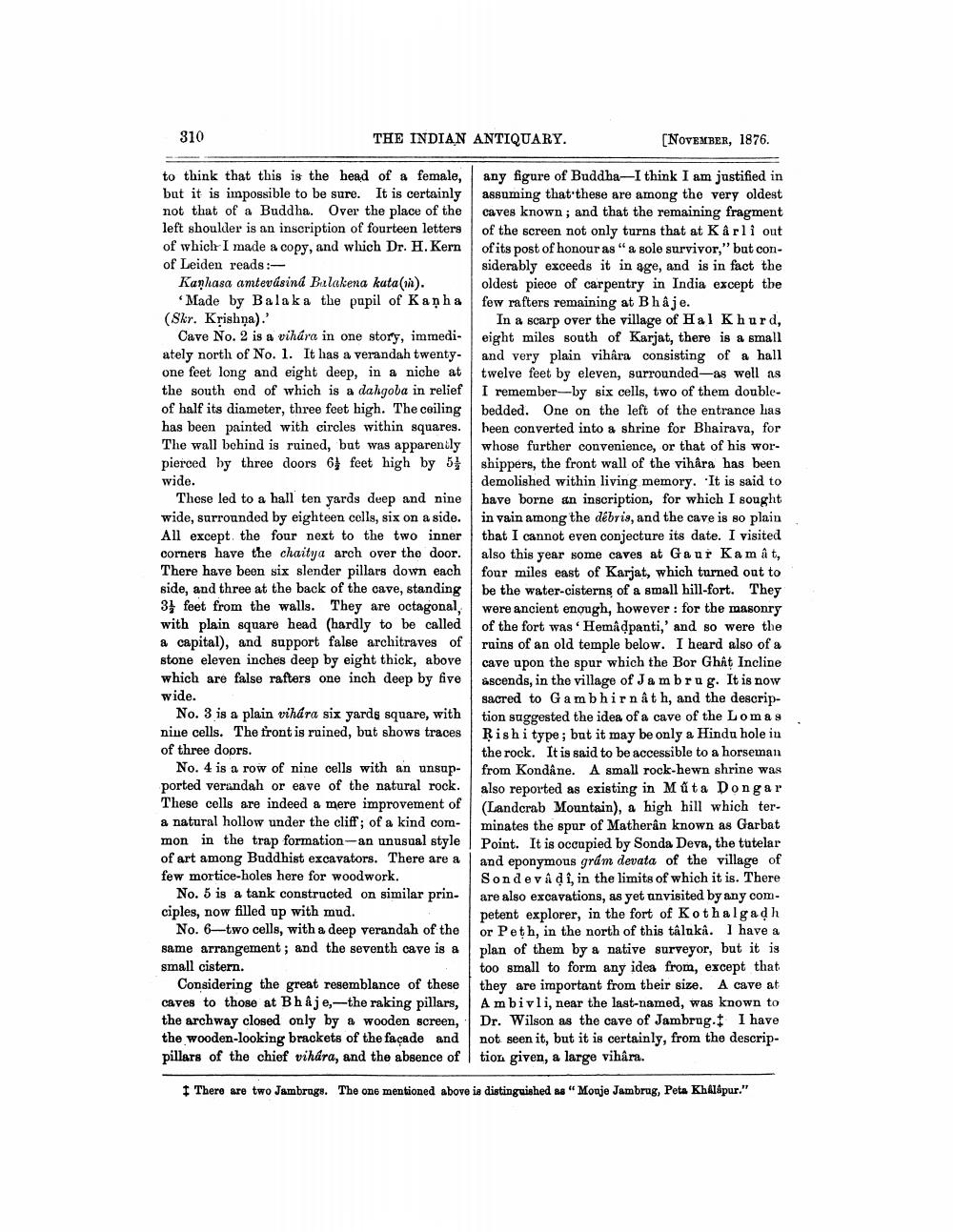________________
310
THE INDIAN ANTIQUARY.
[NOVEMBER, 1876.
to think that this is the head of a female, but it is impossible to be sure. It is certainly not that of a Buddha. Over the place of the left shoulder is an inscription of fourteen letters of which I made a copy, and which Dr. H. Kern of Leiden reads :
Kanhasa amteväsiná Bulakena kata().
Made by Balaka the pupil of Kanha (Skr. Krishna).
Cave No. 2 is a vihára in one story, immedi- ately north of No. 1. It has a verandah twenty- one feet long and eight deep, in a niche at the south end of which is a dahgoba in relief of half its diameter, three feet high. The ceiling has been painted with circles within squares. The wall behind is ruined, but was apparently pierced by three doors 6 feet high by 51 wide.
These led to a hall ten yards deep and nine wide, surrounded by eighteen cells, six on a side. All except the four next to the two inner corners have the chaitya arch over the door. There have been six slender pillars down each side, and three at the back of the cave, standing 3} foet from the walls. They are octagonal, with plain square head (hardly to be called a capital), and support false architraves of stone eleven inches deep by eight thick, above which are false rafters one inch deep by five wide.
No. 3 is a plain vihara six yards square, with nine cells. The front is ruined, but shows traces of three doors.
No. 4 is a row of nine cells with an unsapported verandah or eave of the natural rock. These cells are indeed a mere improvement of a natural hollow under the cliff; of a kind common in the trap formation-an unusual style of art among Buddhist excavators. There are a few mortice-holes here for woodwork.
No. 5 is a tank constructed on similar prin. ciples, now filled up with mud.
No. 6—two cells, with a deep verandah of the same arrangement; and the seventh cave is a small cistern.
Considering the great resemblance of these caves to those at Bhâje,--the raking pillars, the archway closed only by a wooden screen, the wooden-looking brackets of the facade and pillars of the chief vihára, and the absence of
any figure of Buddha-I think I am justified in assuming that these are among the very oldest caves known; and that the remaining fragment of the screen not only turns that at Karli out of its post of honour as "a sole survivor," but considerably exceeds it in age, and is in fact the oldest piece of carpentry in India except the few rafters remaining at Bhâje.
In a scarp over the village of Hal Khurd, eight miles south of Karjat, there is a small and very plain vihara consisting of a hall twelve feet by eleven, surrounded—as well as I remember-by six cells, two of them doublebedded. One on the left of the entrance has heen converted into a shrine for Bhairava, for whose further convenience, or that of his worshippers, the front wall of the vihara has been demolished within living memory. It is said to have borne an inscription, for which I sought in vain among the debris, and the cave is so plain that I cannot even conjecture its date. I visited also this year some caves at Gaur Kamåt, four miles east of Karjat, which turned out to be the water-cisterns of a small hill-fort. They were ancient enough, however : for the masonry of the fort was Hemadpanti,' and so were the ruins of an old temple below. I heard also of a cave upon the spur which the Bor Ghat Incline ascends, in the village of Jambrug. It is now sacred to Gambhirnàth, and the description suggested the idea of a cave of the Lomas Rishi type; but it may be only a Hindu hole iu the rock. It is said to be accessible to a horseman from Kondâne. A small rock-hewn shrine was also reported as existing in Mūta Dongar (Landcrab Mountain), a high hill which terminates the spur of Matherân known as Garbat Point. It is occupied by Sonda Deva, the tutelar and eponymous grám devata of the village of Sondevadi, in the limits of which it is. There are also excavations, as yet anvisited by any competent explorer, in the fort of Kothalgadh or Peth, in the north of this tâluka. I have a plan of them by a native surveyor, but it is too small to form any idea from, except that they are important from their size. A cave at A mbivli, near the last-named, was known to Dr. Wilson as the cave of Jambrug. I have not seen it, but it is certainly, from the description given, a large vihara.
I There are two Jambruge. The one mentioned above is distinguished as "Monje Jambrug, Peta Kh Al&pur."




